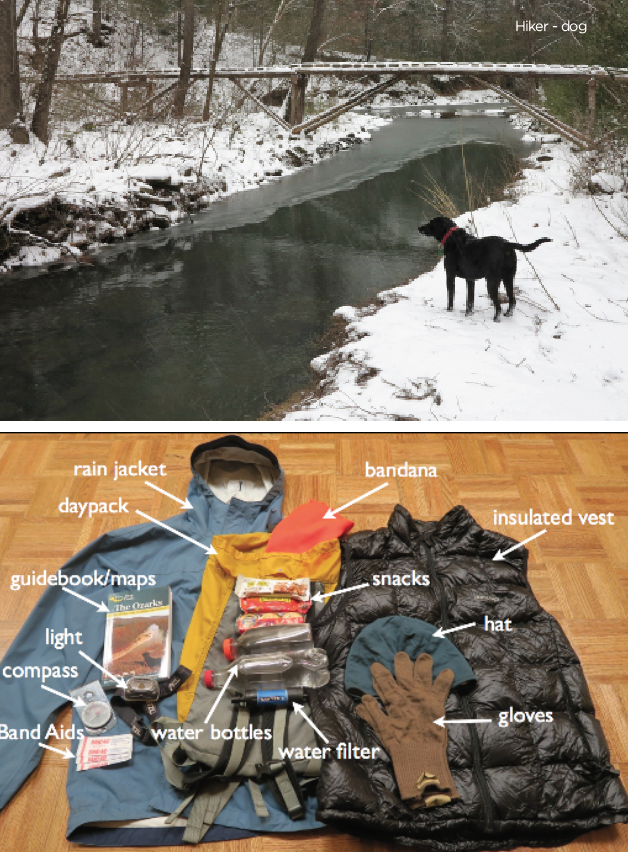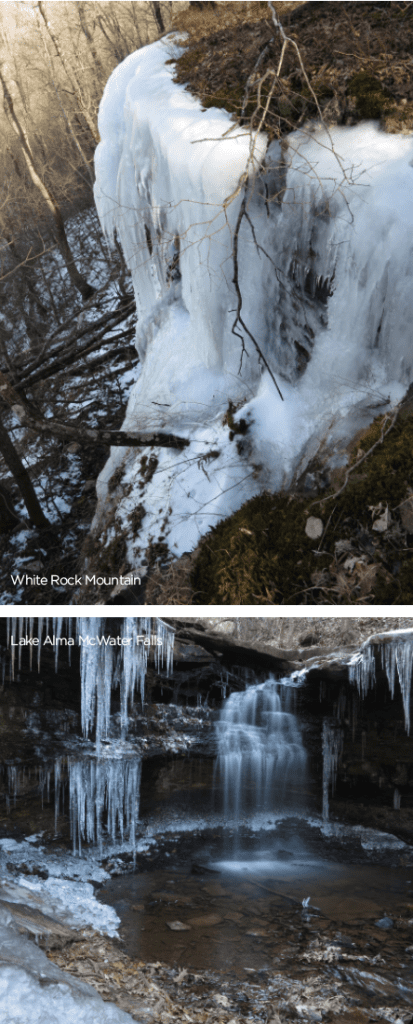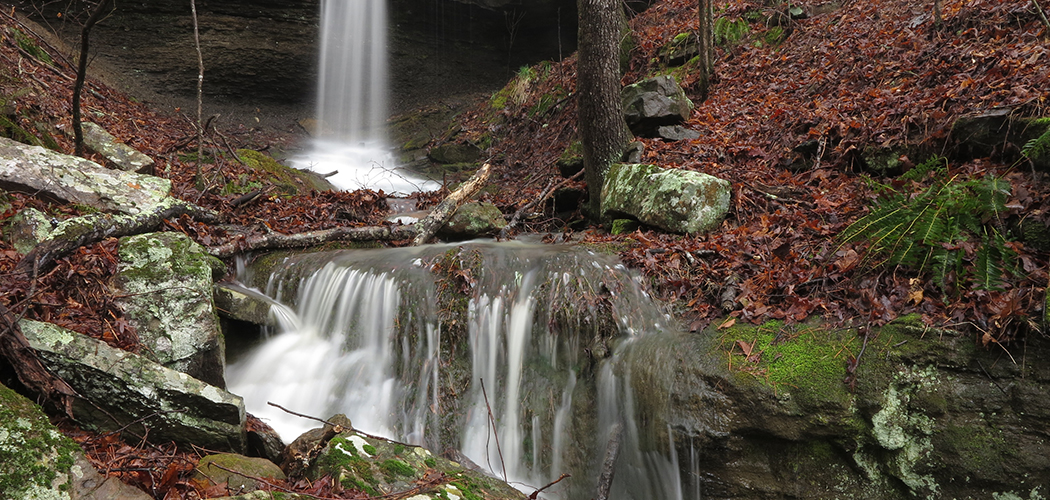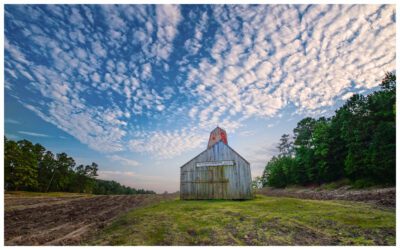[title subtitle=”words and images: Jim Warnock”][/title]
A frozen fog bathed the valley below as I huffed my way up White Rock Mountain in Arkansas’ Ozark National Forest. Branches, outlined in icy crystals, sprinkled sparkling dust on my shoes as I brushed by. Later that same morning, I paused to say a quiet thank-you for the frost flowers, with tender tips that looked like angels’ wings scattered across the forest floor. I’ve come to understand that frost flowers are fragile gifts for those who rise early in winter.
 That experience was from one of many delightful winter mornings I’ll never forget. Sadly, many who enjoy hiking trails in more moderate temperatures will miss out because of their hesitancy about hiking in cold weather.
That experience was from one of many delightful winter mornings I’ll never forget. Sadly, many who enjoy hiking trails in more moderate temperatures will miss out because of their hesitancy about hiking in cold weather.
While fall and spring are favorite seasons in the Ozarks, winter is my most treasured. If you brave the chilly temperatures, you’ll see fantastic ice formations, crystal clear creeks, and colorful rock displays. Bluffs and views usually obscured by foliage reveal themselves in the distance, and wildlife often hidden during other times of the year are in full view.
Just as important as what you’ll see is what you won’t see. You won’t see crowds! Popular locations regularly covered with people during spring or fall become solitary and quiet, allowing you to explore freely and easily. You’ll also avoid ticks, mosquitoes, and snakes during winter, and that drippy perspiration so common when you exert yourself outdoors in the Ozarks at other times of the year.
What to wear? What to take? Will a bear get me? Answering these questions can ensure that you continue hiking in the winter months. First, the bear question. If you see one, count yourself as lucky. I’ve only seen two bears in Arkansas, and both were moving quickly away from me. Since you’re not camping, food storage and cooking, which might attract bears, aren’t a concern.
If the weather is nice, any clothes will do, but during winter, avoid cotton. When cotton gets moist in the humid Ozarks, it stays wet, making you colder. Opt for quick-drying synthetics like polyester and nylon. For added insurance against the elements, put warm gloves and a hat in a rain jacket pocket and stuff it in the bottom of your daypack. Wear layers so you can add or take away clothing as you walk. During deer season, tie a hunter orange bandana to your daypack or wear a blaze orange hat.
Happy feet are essential in any season, but especially winter. Wear wool blend socks and avoid cotton unless you like blisters and soggy feet. Any tennis shoes of reasonable strength are adequate for day hiking in winter, even if snow is in the forecast. I use trail running shoes year-round, even for extended backpacking trips.
 Staying hydrated helps keep you warm and healthy, and the same applies if you have a canine hiking partner. I always check the map to be sure my trail buddy, Hiker-dog, will have access to water. I carry a plastic water bottle in my daypack and a second smaller bottle in my front pants pocket. If temps drop below freezing, my water stays warm in my pocket, and it’s easy to sip as I walk. Carrying a small Sawyer water filter (available at specialty stores and online) in your pack for added insurance is a cheap, lightweight way to make new friends if you meet others who are short on water.
Staying hydrated helps keep you warm and healthy, and the same applies if you have a canine hiking partner. I always check the map to be sure my trail buddy, Hiker-dog, will have access to water. I carry a plastic water bottle in my daypack and a second smaller bottle in my front pants pocket. If temps drop below freezing, my water stays warm in my pocket, and it’s easy to sip as I walk. Carrying a small Sawyer water filter (available at specialty stores and online) in your pack for added insurance is a cheap, lightweight way to make new friends if you meet others who are short on water.
Carry snacks to munch on as you hike. I tend to graze on day hikes, but you might like to stop for lunch at a scenic spot. Layer up because you’ll cool down fast when not moving.
When hiking in winter, be prepared in case things don’t go as planned. Toss a small LED light into your backpack so you won’t worry about darkness if the walk takes longer than expected. Stow a reflective thermal blanket or large trash bag in the bottom of your pack as an emergency shelter. Carry a map and compass and stay on established trails. If you’re ever unsure of the route, stop and backtrack. Winter is no time to spend the night in the woods unless you’re backpacking and prepared for cold weather sleeping.
I hope these tips inspire you to layer up and hit the trails this winter. If you go, you’ll tuck many visual gifts into your memory while gaining energy from the crisp mountain air of the Ozarks.
To get started, try the Lake Alma Trail, on Mountain Grove Road in Alma, as a short out-and-back to a waterfall that flows after rain. Following a big freeze, you’ll see beautiful icy displays on this easy 1.5-mile trek. If you’re an experienced hiker, do the whole 4-mile loop, but be prepared for the two creek crossings. If you pass a lanky fellow with a black Lab, please say hello to Hiker-dog and stop for a quick visit. We hope to see you on the trails!
Jim Warnock is the author of Five Star Trails: The Ozarks, a guidebook that covers the Ozarks of Arkansas and Missouri and includes the Lake Alma Trail. He has thru-hiked the 180-mile Ozark Highlands Trail and 223-mile Ouachita Trail in Arkansas as well as the 210-mile John Muir Trail in California. Follow his, and Hiker-dog’s, adventures at OzarkMountainHiker.com.




